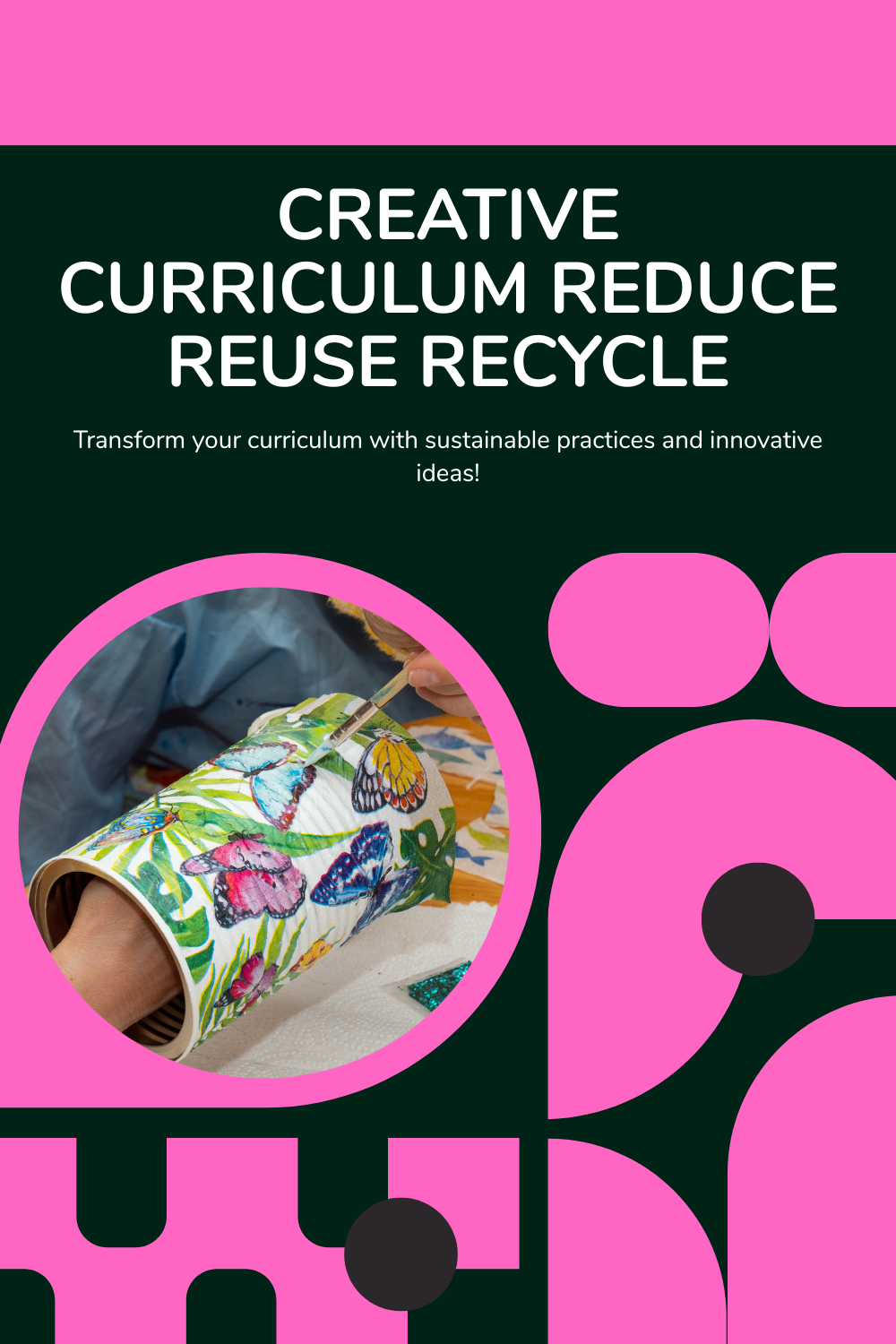As the world becomes more aware of the importance of sustainability, it’s not just industries or governments that need to adopt greener practices education systems have a vital role to play too.
In fact, integrating sustainable practices like reducing, reusing, and recycling within the curriculum is an opportunity that can teach the next generation the importance of environmental responsibility.
But how exactly can we weave these principles into education? How can we make learning not only informative but also environmentally conscious?
In this article, I will explore how a creative curriculum can reduce waste, reuse resources, and recycle knowledge all while fostering a sense of responsibility and creativity in students.
Why Should We Focus on Sustainability in Education?
Before diving into the practical aspects of integrating sustainability into education, let’s first address why it matters.
Environmental sustainability is no longer an optional practice; it’s a necessity. According to the United Nations, the global population will reach approximately 9.7 billion by 2050, further increasing the demand for resources.
This means the pressure on natural resources will grow even more, making it crucial for future generations to be aware of and engage in sustainable practices.
By embedding sustainability into the educational system, we aren’t just teaching about the environment we are empowering students to become responsible stewards of the planet.
Whether it’s in how they manage their classroom resources or how they approach solving real-world problems, sustainability can shape the way they think, act, and create.
As an educator, have you ever wondered how you can actively teach students about environmental consciousness in a fun, creative, and engaging way? Here’s where the concept of “Reduce, Reuse, Recycle” comes in.
The Importance of a Sustainable Curriculum
As we begin thinking about sustainability in education, the first question to address is: Why does it matter? Simply put, a sustainable curriculum is one that teaches students not just the content they need to know, but also how to live and work in ways that are environmentally responsible.
By embracing the “Reduce, Reuse, Recycle” mantra, schools can take an active role in addressing global challenges like waste reduction, resource management, and ecological awareness.
Sustainability as a Core Value
Embedding sustainability within a curriculum means placing environmental awareness at the heart of education. When students are taught about sustainability, they are encouraged to see themselves as part of a global community with a shared responsibility for the future of the planet.
By raising an environment where students actively engage with sustainability, educators are cultivating a sense of responsibility in their students that they can carry forward throughout their lives.
For instance, students could be involved in creating eco-friendly art projects or conducting waste audits to better understand how they can reduce consumption.
These hands-on activities not only enhance learning but also provide real-world applications of sustainable principles.
The Environmental Benefits
By reducing waste, reusing materials, and recycling resources, schools can help reduce their carbon footprints. For example, reusing classroom materials like paper or plastic containers can save resources and money, while also teaching students the value of upcycling.
It’s not just about minimizing environmental harm; it’s about actively making choices that create a positive impact.
How to Integrate “Reduce, Reuse, Recycle” into the Curriculum
Now that we understand the “why,” let’s look at the “how.” Integrating sustainability into the curriculum doesn’t have to be difficult, but it does require a creative approach. Let’s break it down into simple steps for you to implement in your school or classroom.
1. Reduce: Teaching Students About Waste Minimization
Start by teaching students how to reduce waste in the classroom. This can include simple actions like using digital assignments to reduce paper usage, encouraging reusable water bottles, and reducing food waste during lunch breaks.
Example Activity: Waste Audit
A great way to make this concept tangible for students is by conducting a waste audit. Have students track how much waste their classroom produces in a day. From paper to plastic, they can record and analyze the types of materials being thrown away. This can be followed by discussions on how to minimize these materials and adopt waste-reducing strategies.
2. Reuse: Finding Creative Ways to Recycle Materials
Reusing materials helps minimize the demand for new resources. In your classroom, this can mean turning everyday items into teaching tools. For instance, paper scraps can be repurposed into craft materials, or plastic containers can be reused as storage.
Example Activity: Upcycled Art Projects
Host a craft day where students are encouraged to use discarded materials like cardboard, old magazines, or fabric scraps to create artwork. Not only does this reduce waste, but it also encourages creativity.
3. Recycle: Creating a Cycle of Sustainability
Recycling involves converting waste into reusable material, and it can be taught in both a practical and conceptual way. On a practical level, you can set up recycling bins in your classroom for paper, plastic, and metals, and teach students how to sort them correctly.
Example Activity: DIY Recycled Stationery
Instead of buying new stationery, why not try a DIY recycled version? For instance, students can create their own recycled paper using old newspapers, or transform plastic bottles into pencil holders. By using what’s available, students can understand the value of repurposing materials.
Table: Example of Classroom Activities and How They Align with the “Reduce, Reuse, Recycle” Concept
| Activity | Concept Covered | Details |
| Waste Audit | Reduce | Students track the types of waste produced and find ways to reduce it. |
| Upcycled Art Projects | Reuse | Students use discarded materials to create artwork and projects. |
| DIY Recycled Stationery | Recycle | Students create recycled paper and re-use plastic containers. |
Step-by-Step Guide for Implementing Sustainability
Now that you have some foundational ideas, let’s dive into the practicalities of implementing these activities in your classroom.
Step 1: Assess Your Classroom’s Current Practices
Before implementing changes, take stock of what is already happening in your classroom or school. Are there any existing sustainability practices in place? If not, where can you start? This self-assessment will give you a starting point for how to proceed.
Step 2: Plan Activities Around Sustainability
Once you’ve assessed where you stand, it’s time to plan specific activities that align with the “Reduce, Reuse, Recycle” philosophy. Each activity should have clear learning objectives and outcomes, making sure students understand not just the “how” but also the “why” behind each action.
For example, an art project could have students create sculptures from recycled materials while also learning about the environmental impact of waste. This provides a dual benefit of creativity and sustainability education.
Step 3: Introduce the Concept Gradually
Don’t overwhelm your students with too many changes at once. Instead, introduce sustainability concepts gradually, starting with the basics. For example, you might begin with a simple recycling program, then progress to more complex projects like waste audits or upcycling challenges.
Step 4: Celebrate Successes and Reflect
After completing a sustainability activity, take the time to reflect on what went well and what could be improved. Recognizing students’ efforts and successes helps to reinforce the importance of sustainability.
Common Mistakes to Avoid
While teaching sustainability is a noble cause, there are a few common mistakes that educators can make when trying to implement these practices in the classroom.
1. Focusing Only on One Aspect of Sustainability
Many educators focus on just one aspect – for example, recycling – and forget about other components like reducing waste or reusing materials. A comprehensive approach that includes all three pillars of sustainability will lead to a more impactful and holistic understanding.
2. Overwhelming Students with Too Much Information
Sustainability can be a complex topic, and presenting too much information at once can overwhelm students. Break down concepts into digestible parts, and make sure each lesson is engaging and relevant to their lives.
3. Lack of Real-World Application
Students need to understand how sustainability concepts apply to the real world. Avoid focusing solely on theory. Ensure that lessons are hands-on and relatable. For example, conducting a recycling drive or creating a sustainable garden will help students connect theory to action.
Conclusion
Incorporating sustainability into the curriculum through the principles of “Reduce, Reuse, Recycle” doesn’t just benefit the planet it also encourages creativity, problem-solving, and environmental awareness in students.
By using these practices, we are preparing students to think critically about the resources they consume and how they can make a positive impact.
Key Takeaways:
- A sustainable curriculum focuses on teaching students the value of reducing waste, reusing materials, and recycling resources.
- Creative activities, such as upcycled art projects and DIY recycled stationery, can make learning fun while promoting sustainability.
- Educators should integrate sustainability gradually, ensuring students understand the principles behind their actions.
- Avoid focusing on one aspect of sustainability; instead, aim for a balanced approach that includes reducing, reusing, and recycling.




